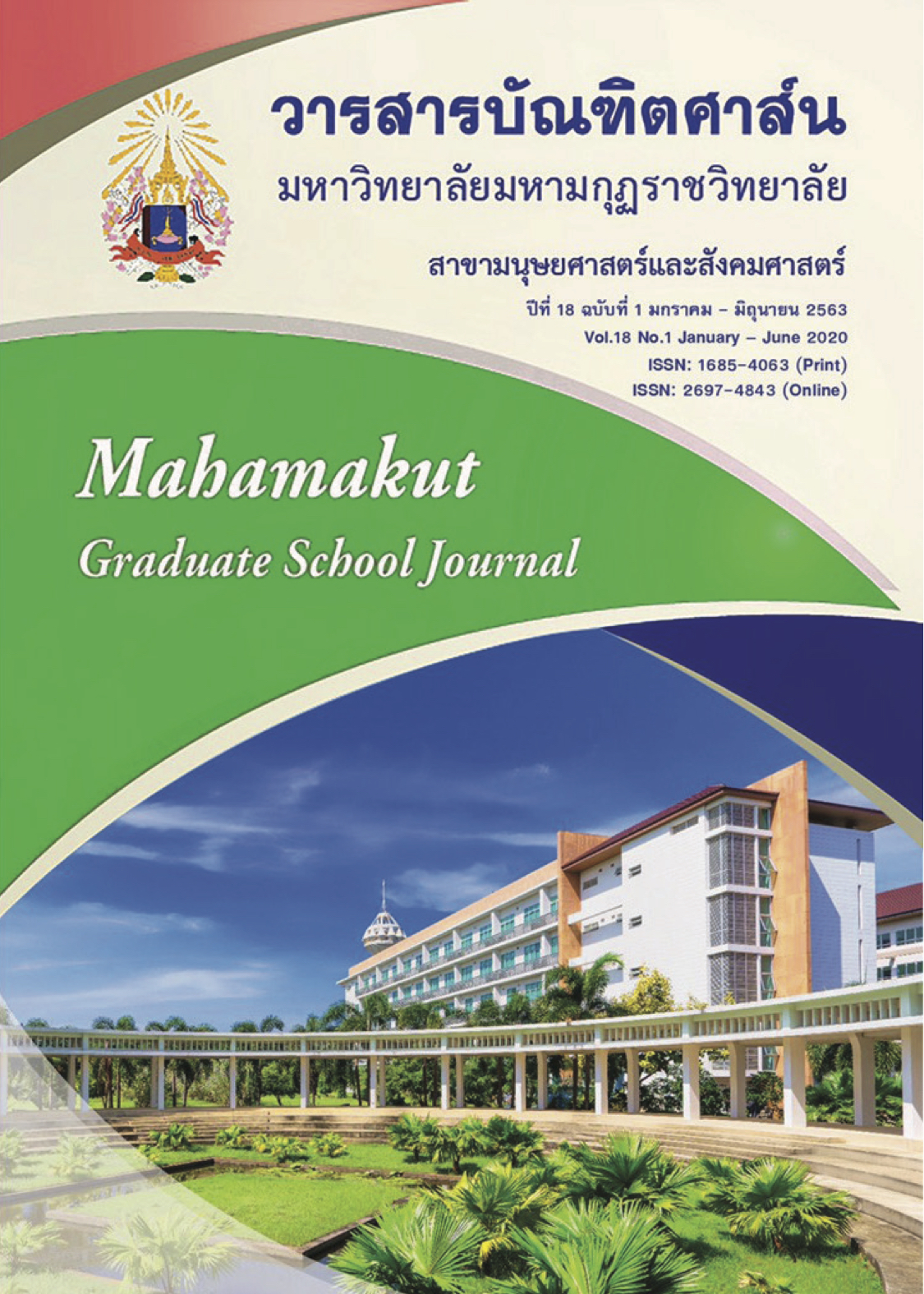การใช้นวัตกรรมการจัดการเรียนการสอนวิชาพระพุทธศาสนาสำหรับนักเรียนโรงเรียนประถมศึกษาชั้นปีที่ ๖ อำเภอบางบัวทอง จังหวัดนนทบุรี
คำสำคัญ:
การใช้นวัตกรรม, การจัดการเรียนการสอนวิชาพระพุทธศาสนา, นักเรียนโรงเรียนประถมศึกษาบทคัดย่อ
การวิจัยนี้มีวัตถุประสงค์ 1) เพื่อศึกษาสภาพการใช้นวัตกรรมการจัดการเรียนการสอนวิชาพระพุทธศาสนา 2) เพื่อศึกษาการใช้นวัตกรรมการจัดการเรียนการสอนวิชาพระพุทธศาสนาสำหรับนักเรียน 3) เพื่อเสนอแนวทางการใช้นวัตกรรมนวัตกรรมการจัดการเรียนการสอนวิชาพระพุทธศาสนาสำหรับนักเรียนโรงเรียนประถมศึกษาชั้นปีที่ 6 อำเภอบางบัวทองจังหวัดนนทบุรี โดยใช้การวิจัยแบบผสมผสานระหว่างเชิงปริมาณและเชิงคุณภาพเครื่องมือที่ใช้ในการวิจัยเป็นแบบสอบถามโดยมีกลุ่มตัวอย่างเป็นครูโรงเรียนประถมศึกษา จำนวน 210 คน และสัมภาษณ์ผู้บริหารและครูจำนวน 5 คน วิเคราะห์โดยหาค่าเฉลี่ย ค่าส่วนเบี่ยงเบนมาตรฐาน และการวิเคราะห์เนื้อหา
ผลการวิจัยพบว่า สภาพการใช้นวัตกรรมการจัดการเรียนการสอนวิชาพระพุทธศาสนา ภาพรวมทั้ง 5 ด้าน ครูมีความคิดเห็น อยู่ในระดับมาก ได้แก่ นวัตกรรมการจัดกิจกรรมการเรียนรู้ รองลงมาได้แก่ นวัตกรรมการวัดและประเมินผล นวัตกรรมกระบวนการเรียนรู้ นวัตกรรมสื่อการสอน และนวัตกรรมทางด้านหลักสูตรตามลำดับ
ผลศึกษาการใช้นวัตกรรมนวัตกรรมการจัดการเรียนการสอนวิชาพระพุทธศาสนาสำหรับนักเรียน ได้แก่ ด้านนวัตกรรมทางด้านหลักสูตรวิเคราะห์หลักสูตรเกี่ยวกับสภาพปัญหา และความต้องการของสังคม ชุมชน และท้องถิ่น จัดทำโครงสร้างหลักสูตรและสาระต่างๆ ด้านนวัตกรรมกระบวนการเรียนรู้ ครูผู้สอนมีชุดการเรียน ชุดการสอน แบบฝึกทักษะ ชุดการฝึกทักษะการเรียนรู้บทเรียนสำเร็จรูปแบบสื่อผสม บทเรียนโปรแกรม เป็นต้น มีวิธีการสอนคิด วิธีการสอนโดยการจัดการเรียนรู้แบบร่วมมือ CIPPA MODEL ด้านนวัตกรรมสื่อการสอน ใช้คอมพิวเตอร์ช่วยสอน มัลติมีเดีย การประชุมทางไกล ชุดการสอน วีดิทัศน์แบบมีปฎิสัมพันธ์ เลือกใช้สื่อได้อย่างเหมาะสม สื่อจะช่วยให้การจัดกิจกรรม การเรียนการสอน บรรลุจุดมุ่งหมายการเรียนการสอน ด้านนวัตกรรมการจัดกิจกรรมการเรียนรู้จัดกิจกรรมทางพุทธศาสนา กิจกรรมสวดมนต์ นั่งสมาธิ ปฏิบัติธรรม กิจกรรมมารยาทชาวพุทธ กิจกรรมวาดภาพ ระบายสีวันสำคัญทางพุทธศาสนา ในวันสำคัญทางพุทธศาสนา เช่น วันมาฆบูชา วันวิสาขบูชา วันอาสาฬหบูชา วันเข้าพรรษา วันออกพรรษา เป็นต้น ด้านนวัตกรรมการวัดและประเมินผล โดยมีการประเมินผลผ่านคลังข้อสอบออนไลน์ สั่งงานผ่านอินเตอร์เน็ต สั่งผ่านโทรศัพท์มือถือหรือคอมพิวเตอร์และให้นักเรียนได้ส่งงานหรือข้อสอบผ่านคอมพิวเตอร์หรือโทรศัพท์มือถือ ผ่านอีเมล์
แนวทางการใช้นวัตกรรมนวัตกรรมการจัดการเรียนการสอนวิชาพระพุทธศาสนาสำหรับนักเรียนโรงเรียนประถมศึกษาชั้นปีที่ 6 อำเภอบางบัวทองจังหวัดนนทบุรีโครงสร้างทั่วไปของเนื้อหาวิชาส่งเสริมการพัฒนาทักษะการคิดออกแบบ วิเคราะห์เอกสารหลักสูตร สอดคล้องกับวิสัยทัศน์ เป้าหมายและคุณลักษณะอันพึงประสงค์สร้างประสบการณ์จากการเรียนรู้ โดยฝึกปฏิบัติในวิชาพระพุทธศาสนาเพื่อเพิ่มพูนทักษะ
ครูผู้สอนมีชุดการเรียน/ชุดการสอนโดยผ่านการร่วมมือของนักเรียน ผู้สอนสามารถถ่ายทอดความรู้ สื่อความหมายและความเข้าใจอย่างมีประสิทธิภาพมีคอมพิวเตอร์ช่วยสอนมัลติมีเดีย สื่อออนไลน์และเลือกใช้สื่ออย่างเหมาะสม จัดกิจกรรมการเรียนรู้วิชาพระพุทธศาสนา ก่อให้เกิดการเรียนรู้และประสบการณ์ใหม่ ส่งเสริมความสัมพันธ์ที่ดีระหว่างนักเรียน เพื่อนและครูผู้สอน มีแบบทดสอบวัดประเมินผลก่อนและหลังเรียน ทำข้อสอบวิชาพุทธศาสนาผ่านมือถือโดยใช้ google form สั่งงานผ่านอินเตอร์เน็ต สั่งผ่านโทรศัพท์มือถือหรือคอมพิวเตอร์เพื่อวัดและประเมินผลผู้เรียนอย่างรวดเร็วและมีประสิทธิภาพสมกับเป็นยุคดิจิทัล
เอกสารอ้างอิง
จุฑามาศ กาญจนธรรม และเด่น ชะเนติยัง. (2558). การพัฒนารูปแบบเทคโนโลยีสารสนเทศและการสื่อสารเพื่อการบริหารจัดการในสถานศึกษาสังกัดสำนักงานเขตพื้นที่การศึกษาประถมศึกษาจันทบุรี เขต 2. วิทยานิพนธ์ ศึกษาศาตรมหาบัณฑิต. บัณฑิตวิทยาลัย: มหาวิทยาลัยมหาสารคาม.
ชัยวัฒน์ สุทธิรัตน์. (2559). ๘๐ นวัตกรรมการจัดการเรียนรู้ที่เน้นผู้เรียนเป็นสำคัญ. พิมพ์ครั้งที่ 7. นนทบุรี: พี บาลานซ์ดีไซด์แอนปริ๊นติ้ง.
ชูศรี วงศ์รัตนะ. (2541). เทคนิคการใช้สถิติเพื่อการวิจัย. พิมพ์ครั้งที่ 7. กรุงเทพฯ: เทพเนรมิต.
พระกันตพัฒน์ สุภทฺโท (เจริญจรัสวาศน์). (2560). การใช้นวัตกรรมและเทคโนโลยีการจัดการเรียนรู้วิชาพระพุทธศาสนา สำหรับนักเรียนระดับประถมศึกษา เขตคลองเตย สังกัดกรุงเทพมหานคร. วิทยานิพนธ์พุทธศาสตรมหาบัณฑิต สาขาวิชาการบริหารการศึกษา. บัณฑิตวิทยาลัย: มหาวิทยาลัยมหาจุฬาลงกรณราชวิทยาลัย.
พระกันตพัฒน์ สุภทฺโท (เจริญจรัสวาศน์). (2560). การใช้นวัตกรรมและเทคโนโลยีการจัดการเรียนรู้วิชาพระพุทธศาสนา สำหรับนักเรียนระดับประถมศึกษา เขตคลองเตย สังกัดกรุงเทพมหานคร. วิทยานิพนธ์พุทธศาสตรมหาบัณฑิต สาขาวิชาการบริหารการศึกษา. บัณฑิตวิทยาลัย: มหาวิทยาลัยมหาจุฬาลงกรณราชวิทยาลัย.
สมนึก เอื้อจิระพงษ์พันธ์และคณะ. (2553). นวัตกรรม : ความหมายประเภทและความสำคัญต่อการเป็นผู้ประกอบการ", วารสารบริหารธุรกิจ, (ปีที่ ๓๓ ฉบับที่ ๑๒๘ ตุลาคม-ธันวาคม, ๒๕๕๓)
สุคนธ์ สินธพานนท์. (2553). นวัตกรรมการเรียนการสอนเพื่อพัฒนาคุณภาพของเยาวชน. กรุงเทพฯ: อักษรเจริญทัศน์.
สำนักวิชาการและมาตรฐานการศึกษา สำนักงานคณะกรรมการการศึกษาขั้นพื้นฐาน กระทรวงศึกษาธิการ. (2552). สังคมศึกษา ศาสนา และวัฒนธรรม. พิมพ์ครั้งที่ ๑. กรุงเทพฯ: โรงพิมพ์ชุมนุมสหกรณ์การเกษตรแห่งประเทศไทย จำกัด.
สุพรรณี มีภูเวียง. (2550). การจัดกิจกรรมการเรียนรู้ โดยใช้บทเรียนสำเร็จรูปประกอบ STAD กลุ่มสาระสังคม ศาสนาและวัฒนธรรม เรื่อง วันสำคัญทางพระพุทธศาสนาชั้นประถมศึกษาปีที่ ๓. วิทยานิพนธ์การศึกษามหาบัณฑิต. สาขาวิชาหลักสูตรและการสอน. บัณฑิตวิทยาลัย: มหาวิทยาลัยมหาสารคาม.
วิไล ตั้งจิตสมคิด. (2534). การศึกษาและความเป็นครูไทย. กรุงเทพฯ: โอ เอส พริ้นติ้ง เฮ้าส์.
วรวทิย์ นิเทศศิลป์. (2551). สื่อและนวตักรรมแห่งการเรียนรู้. ปทุมธานี: สกายบุ๊กส์.
Andrew E. Fluck. (2003). Integration or Transformation? A cross – national study of Information and Communication Technology in School Education.
Cronbach, Lee J. (1971). Essentials of psychological testing, 4 th ed. New York: Harper & Row.
Dorothy Bennett, and others), (2000). It All Depends: Strategies for Designing Technologies forEducation Change, Retrieved October 10, 2009.
ดาวน์โหลด
เผยแพร่แล้ว
รูปแบบการอ้างอิง
ฉบับ
ประเภทบทความ
สัญญาอนุญาต
บทความวิชาการและบทความวิจัยในวารสารฉบับนี้ถือเป็นความรับผิดชอบของผู้เขียนเท่านั้น บทความที่ได้รับการตีพิมพ์ในวารสารบัณฑิตศาส์น ถือเป็นลิขสิทธิ์ของมหาวิทยาลัยมหามกุฏราชวิทยาลัย ตามพระราชบัญญัติลิขสิทธิ์



